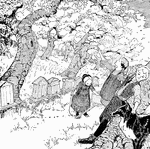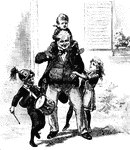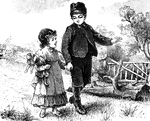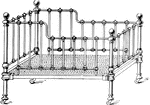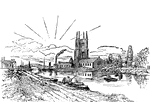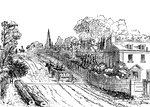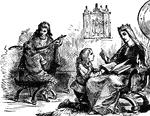
Charles Lamb
A famous English essayist, best known for his Essays of Elia and for the children's book Tales…

Cravat bow
"Plait the ribbon a distance from the end to allow for a streamer or bow end. Hold the plaits with the…
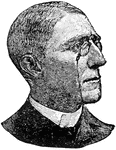
James Riley
A beloved American writer and poet called the "Hoosier poet" and America's "Children's Poet" made a…
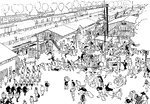
Ruhleben Prison Camp
"A prophetic birds eye view of Ruhleben Prison Camp when the war ends."-1916; Drawing by Hobart Egremont,…

Siphon
A bent tube with limbs of unequal length, used for drawing liquids from one vessel into another.
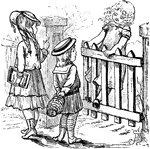
Young Girls
This illustration shows three young girls in their school clothes gathered around a fence.

Jointed Rock
This illustration shows a jointed structure. In this drawing, there are two systems of joints or divisional…
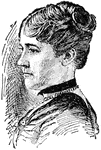
Mary A. McElroy
The sister of Chester A. Arthur, the 21st President of the United States. She was a hostess for his…

Triumph of Columbus
The Triumph of Columbus. A fac-simile of the original sketch by Columbus himsef, was sent by him from…

Tiahuanacu Image
Enlarged drawing of the bas-relief on the broken doorway. Details that show Tiahuanacu existed.

Black Scale
A drawing of the newly hatched larva, viewed from beneath, with enlargements of anal extremity viewed…

Compasses
"The compasses, next to the T square and triangles, are used more than any other instrument. A pencil…
Compasses
"The compasses, next to the T square and triangles, are used more than any other instrument. A pencil…
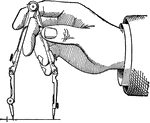
Compasses
"The compasses, next to the T square and triangles, are used more than any other instrument. A pencil…
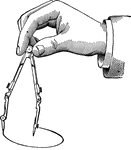
Compasses
"The compasses, next to the T square and triangles, are used more than any other instrument. A pencil…
Compasses
"The compasses, next to the T square and triangles, are used more than any other instrument. A pencil…
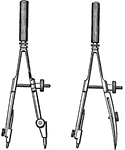
Compasses
"The compasses, next to the T square and triangles, are used more than any other instrument. A pencil…
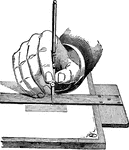
Ruling Pen
"For drawing ink lines other than arcs of circles, the ruling pen is used. It should be held as nearly…

Ruling Pen
"For drawing ink lines other than arcs of circles, the ruling pen is used. It should be held as nearly…
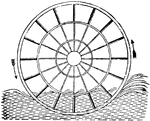
Ordinary Paddle-wheel
"The usual form of paddle-wheel, that is called the radial, in which the floats are fixed. It will be…
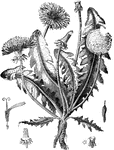
Common Dandelion
A large genus of flowering plants. It is popular amongst children attempting to blow the pedals off…
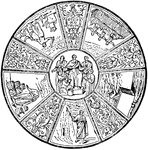
Fresco Ceiling
"The subjects, begining at the bottom and going to the right, are (1.) Moses striking the rock; (2.)…

Slubbing Frame
"The operation which succeeds that of the drawing frame is slubbing, where the sliver has a certain…

Throstle
"The spinning frame, or throstle, is made with two sets of drawing rollers, one on each side. Between…
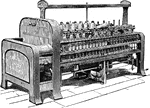
Throstle
"The spinning frame, or throstle, is made with two sets of drawing rollers, one on each side. Between…

Aurelia Aurita
"Tentaculocyst and marginal lappets of Aurelia aurita. In the lefthand figure-ML, marginal lappets;…
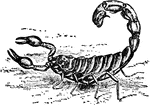
Scorpion
"Drawing from life of the desert scorpion, Buthusaustralis." — The Encyclopedia Britannica, 1910

Scorpion
"Drawing from tlife of the Italian scorpion Euscorpius italicus, Herbst, holding a blue-bottle fly with…

Cup-adjusting Hub
"One end of the cup-adjusting hub, with inward bearings. The cones are formed of one piece with the…
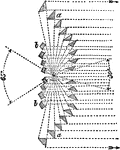
Swans Designs
"Professor Swan's Designs.—Among several ingenious arrangements and new forms of agents proposed by…
Ruling Pen
A form of pen used for drawing lines of even thickness. It commonly consists of two blades which hold…
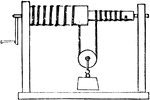
Windlass
"Windlass.—The common windlass for drawing water is another modification of the wheel and axle.…

Crank
"The simplest idea of a crank is that of a handle to a wheel; its action is familiarly illustrated in…

Praying Mantis
"Probably no other insect has been the subject of so many and widespread legends and superstitions as…
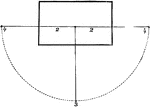
Parallel Perspective
This figure represents the whole of the points and lines requisite for working out a drawing in "parallel…
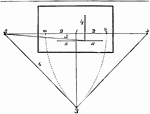
Angular Perspective
This figure comprises the whole of the points and lines preparatory to beginning a drawing in "angular…
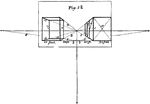
Parallel Perspective
Two upright oblong figures are here represented in parallel perspective. They may be imagined to resemble…

Angular Perspective
This cube has four additional cubes of equal dimensions. This is effected by first drawing the cube…
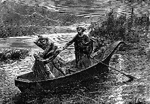
Murder of Prince Arthur
As a kind of joke, John, King Henry's youngest son, had been called Lackland, because he had nothing…

King Henry and His Barons
King Henry was a builder of beautiful churches. Westminster Abbey, as it is now, was one. And he was…

